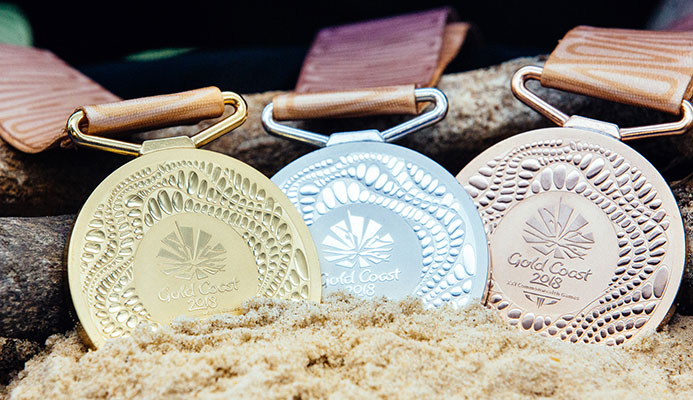The Medal Story
For many generations the Gold Coast coastline has been a place for gathering, meeting and sport. The Medal design represents the soft sand lines which shift with every tide and wave and is symbolic of athletic achievement. As the water moves towards low tide, each wave moves the sand, creating and leaving behind new lines in the sand witnessed by those present.
The continual change of tide represents the evolution in Athletes who are making their mark. Records are made and special moments of elation celebrated. Although the moment in time may be fleeting, it is forever marked within the shells that are brought upon its tidelines.
Medal designer – Delvene Cockatoo-Collins
Delvene Cockatoo-Collins is a local Nunukul, Ngugi and Goenpul woman of Quandamooka Country, who lives and works on Minjerribah, North Stradbroke Island – her mother and grandmothers’ birthplace.
Delvene draws upon inspiration from the moments that are shared with her family, particularly her mother, and the written words of her grandmother. She translates these narratives into her own contemporary interpretations to ensure their continuation.
Delvene was engaged to design the artwork for the Gold Coast 2018 Commonwealth Games medals. She focuses her designs around the beautiful coastlines and the significance of the coast as a place of gathering, meeting and sport.
Delvene’s medal designs have been brought to life by the Royal Australian Mint who are responsible for the production and delivery of the medals.
Commonwealth Games 2018 Gold Medal in handCommonwealth Games 2018 Gold Medal being held by CindyCindy holding hands at the beach
The Medal Ribbon Story
The woven strand of the freshwater reed, yungair, is three reeds woven to form a pattern which resembles many triangles joined together. It is reminiscent of the South-East Queensland and Gold Coast areas.
The traditional technique involves one reed as the working reed, which continually wraps around the other two reeds. Individually each reed has little function or purpose, however when connected together, they are strong and can have many functions, such as carrying babies and food.
It is a skill that has been passed down and shared through the generations. In Delvene’s family, an Aunty is the one who passed it down her mother, who then passed the skill on to her.
Onto the press
Each medal blank is inspected by hand and individually placed into the Mint’s largest coin press. They are struck four times to ensure the design is perfectly formed on the metal surface. The gold and silver medals are struck four times, twice at 280 tonnes and then another two times at 260 tonnes. The bronze medals are also struck four times but at 460 tonnes. Once they are removed from the press, the medals are inspected again, ensuring the medal is faultless and ready to be awarded to the Commonwealth Games champions.
As Official Supporter and Producer of the GC2018 medals, the Royal Australian Mint (the Mint) is responsible for the production and delivery of the medals that will be awarded to a fortunate few athletes from 4-15 April 2018.
The medals are crafted using the Mint’s coin-making process, and the very same presses that are used to make Australian currency.
The process demands precision, attention to detail, and a weight of up to 460 tonnes.
The Mint receives strips of metal and punches out the 63mm diameter circular metal blanks. The blanks are then struck with the design, transforming the metal into a medal.
Using this refined process, more than 1,000 medals can be produced per day.
Using a computer-controlled engraving machine, the GC2018 medal design is carefully cut into a reduction punch made of tool steel. It requires a high level of precision and the process can take up to 63 hours. The reduction punch is then used to create the coin dies. The die is the metallic piece that is used to strike the metal, turning it into a medal.

